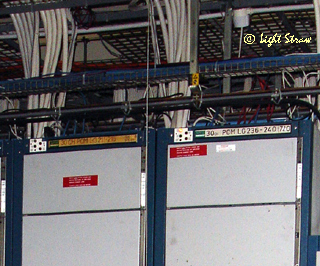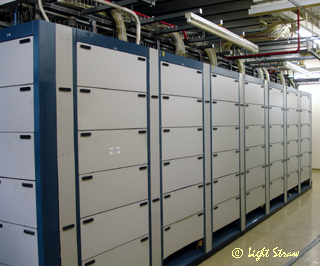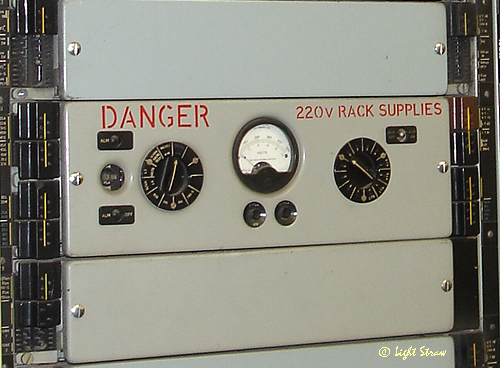Overview
Telecommunications Equipment Practice is...
"A standardised system for physical design of a whole range of
equipment, facilitating its interconnection with other equipment."
The 51-type equipment and racking standard was introduced
into the Post Office in 1951, as a
means to improve equipment layout and density as well as aiding
maintenance.
Over the years, the standards were modified as the equipment evolved
from valve, through transistorised to integrated circuit level, all of
which required different mounting and cooling arrangements.
As the packing density of components has increased, the cooling
requirements, particularly for modern processors has become more
important.
Types
Pre 51-type equipment
Before the adoption of any standard, flat (19 in.) panels were screwed
to steel rack uprights.
- Max height of racking 10 ft. 6 in.
- Rack framework of steel channel and angle.
- Mounting plates secured to both sides of a rack.
- Mounting plates used as chassis.
- Box-type dust covers.
- Rack wiring soldered to connection strips on the
mounting plate.
- 130V high tension and 24V low tension standard supply
voltages.
|
51-type equipment
- Max height of racking 9 ft.
- Folded sheet-steel framework.
- Single-side mounting of equipment on 'rack-side' only.
- Rack-sides installed, back-to-back.
- Jack-in panels.
- Standard panel sizes of 3.5 in., 5.25 in. and 7 in.
- All panels carry a dust cover by means of snap-on
fasteners.
- U-links and rack-side sockets as panel-to-wiring
connections.
- Rack earth and h.t. negative commoned.
- Low tension supply by mains driven panels on individual
racks.
- High tension supply by mains driven panels on
(rack-sides) or distributed from Repeater Station.
|
56-type equipment
"56-type was battleship grey and contained weird old
stuff that no-one dared touch for fear of breaking..."
- Higher packing density by sub division of the shelf.
- Developed during the change from valve to transistor
driven circuits.
|
The 51-type and 56-type equipment practices were developed by Standard
Telephones and Cables Ltd (STC).
The 62-type equipment practice was developed by General Electric Company
Telecommunications Ltd (GEC) and adopted circa 1964.
62-type equipment
"62-type: the standard yellow racks that repeater
stations used to be full of."
- Racks 3230 mm (max) height. Standard height 2740 mm for
repeater stations.
- Rack depth twice that of the 51-type design.
- Printed wiring board, vertical mountings.
- Shelves usually supplied tilted 15 degrees, but can also
be horizontal.
- Standard shelf height 152 mm.
- Standard card connector has 40 contacts.
- Fuse for d.c. power at top-rear of rack.
- Total permitted heat dissipation per rack is 400W.
|
 |
62-type equipment, showing the shelves
inclined at 15 degrees to the horizontal, to facilitate
better airflow and cooling.
Air enters via louvres in rear covers and the solid shelf
base reduced vertical airflow through rack.
Photo: 62-type equipment ©
LSA May 2012.
|
| |
|
TEP-1
Developed from 1972 onwards and introduced circa 1978 primarily to incorporate the transmission and
switching requirements for digital exchange equipment of the System X
era and beyond. The main function of the new practice was 'to house
integrated circuits'.
- Steel pressings to BS 1449 (1972).
- SIUs (Slide In Unit) guides and shelf mountings are
moulded thermoplastic.
- Rack footings are painted.
- Rack side members are zinc-plated and passivated.
- Stainless steel for strength-providing members.
- Covers for front, rear and ends are plastic-coated
aluminium.
- Rack cooling by natural convection.
- Wiring connectors of 2.54mm pitch.
- International Electro-Technical Commission (IEC)
130/14 style connectors with capacity for 96 contacts.
|
TEP-1(E)
- Housing (electronic) equipment.
- Dimensions: depth 260 mm, width 600 mm, height 2600 mm
(max).
- Rack-top alarm and fuse panels and designation strip.
- A front panel forms a kicking plate with
ventilation holes and provision for a mains socket outlet.
- Total permitted heat dissipation per rack is 400W.
|
 |
TEP-1(E) equipment racks, showing the
alarm and designation panels along the top.
Photo: TEP-1(E)PCM 30 equipment
racks ©
LSA May 2012.
|
| |
|
TEP-1(H)
- Housing (hybrid) electronic and electromechanical
equipment.
- Dimensions: depth 630 mm, width 900 mm, height 2164 mm.
- Other racks specified have a depth of 520 mm and heights
varying in steps of 30.48 mm.
- Power supplied via type-44 fuses mounted on either side
of the shelves.
- SIU (Slide In Units) of Planar PWBs (Printed Wiring
Boards) or framed units.
- SIUs of 285 mm high by 345 mm (or 457 mm) depth.
|
 |
TEP-1(H) equipment racks.
Photo: TEP-1(H)equipment
racks ©
LSA Nov 2008.
|
| |
|
"System X used TEP-1H racks (originally - later a design with a door was
used) which were wider and lower and didn't have the shelf alarm and
receiving attention keys."
References
POEEJ Vol 73 Part 3 October 1980
POEEJ Vol 72 Part 3 October 1979
POEEJ Vol 66 Part 1 April 1973
POEEJ Vol 51 Part 3 October 1958
|



